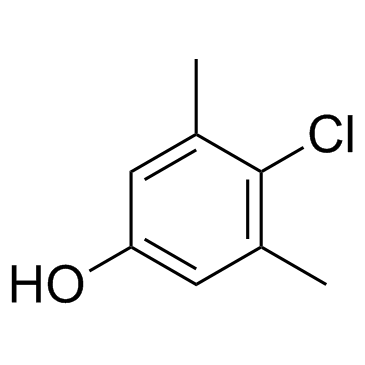Chloroxylenol

Chloroxylenol structure
|
Common Name | Chloroxylenol | ||
|---|---|---|---|---|
| CAS Number | 88-04-0 | Molecular Weight | 156.609 | |
| Density | 1.2±0.1 g/cm3 | Boiling Point | 246.0±0.0 °C at 760 mmHg | |
| Molecular Formula | C8H9ClO | Melting Point | 114-116 °C(lit.) | |
| MSDS | Chinese USA | Flash Point | 105.9±25.9 °C | |
| Symbol |

GHS07 |
Signal Word | Warning | |
|
Cheminformatics analysis of assertions mined from literature that describe drug-induced liver injury in different species.
Chem. Res. Toxicol. 23 , 171-83, (2010) Drug-induced liver injury is one of the main causes of drug attrition. The ability to predict the liver effects of drug candidates from their chemical structures is critical to help guide experimental drug discovery projects toward safer medicines. In this st... |
|
|
Transdermal penetration behaviour of drugs: CART-clustering, QSPR and selection of model compounds.
Bioorg. Med. Chem. 15 , 6943-55, (2007) A set of 116 structurally very diverse compounds, mainly drugs, was characterized by 1630 molecular descriptors. The biological property modelled in this study was the transdermal permeability coefficient logK(p). The main objective was to find a limited set ... |
|
|
Determination of phenolic disinfectants in consumer products by capillary electrophoresis with amperometric detection.
J. Chromatogr. Sci. 48(7) , 584-8, (2010) Numerous disinfection products are widely used in daily life to kill pathogenic microorganisms. However, most disinfectants are organic compounds that might be hazardous to the environment and humans when used excessively. Phenolic disinfectants in disinfecti... |
|
|
Comparison of two in vivo and two ex vivo tests to assess the antibacterial activity of several antiseptics.
J. Hosp. Infect. 58(2) , 115-21, (2004) An ex vivo test was adapted to mimic the in vivo conditions of testing antiseptic activity on human forearms and in the European Standard Hygienic Handwash Test (BSEN 1499). The study was to validate the ex vivo protocols using 4.8% (w/v) para-chloro-meta-xyl... |
|
|
Hand dermatitis: a focus on allergic contact dermatitis to biocides.
Dermatol. Clin. 27(3) , 251-64, v-vi, (2009) Hand dermatitis is a common disease of the skin resulting in significantly decreased quality of life. Allergic contact dermatitis is a frequent cause of hand dermatitis. Recent studies have revealed that biocides used as preservatives are frequent allergens a... |
|
|
Contact inactivation of orthopoxviruses by household disinfectants.
J. Appl. Microbiol. 99(2) , 279-84, (2005) The aim of this study is to identify common household disinfectants that combine significant activity against the type orthopoxvirus, vaccinia virus with minimal impact in terms of potential toxicity and/or damage to household or personal items.Laboratory sca... |
|
|
Use of the 'ex vivo' test to study long-term bacterial survival on human skin and their sensitivity to antisepsis.
J. Appl. Microbiol. 97(6) , 1149-60, (2004) To determine bacterial survival on human skin and their sensitivity to antisepsis.An 'ex vivo' protocol which uses human skin samples placed into diffusion cells, and electron microscopy (EM), were used to study the growth of Staphylococcus aureus, Escherichi... |
|
|
Allergic contact dermatitis to chloroxylenol.
Dermatitis 17(3) , 156-9, (2006) Chloroxylenol, also known as p-chloro-m-xylenol (PCMX), is a compound that has been used as a preservative in cosmetics and as an active agent in antimicrobial soaps. We present two patients with allergic contact dermatitis from PCMX, confirmed by positive (+... |
|
|
Chloroxylenol.
Dermatitis 18(2) , 120-1, (2007)
|
|
|
The antiviral action of common household disinfectants and antiseptics against murine hepatitis virus, a potential surrogate for SARS coronavirus.
Am. J. Infect. Control 37(8) , 649-52, (2009) The 2003 outbreak of severe acute respiratory syndrome (SARS) infected over 8000 people and killed 774. Transmission of SARS occurred through direct and indirect contact and large droplet nuclei. The World Health Organization recommended the use of household ... |